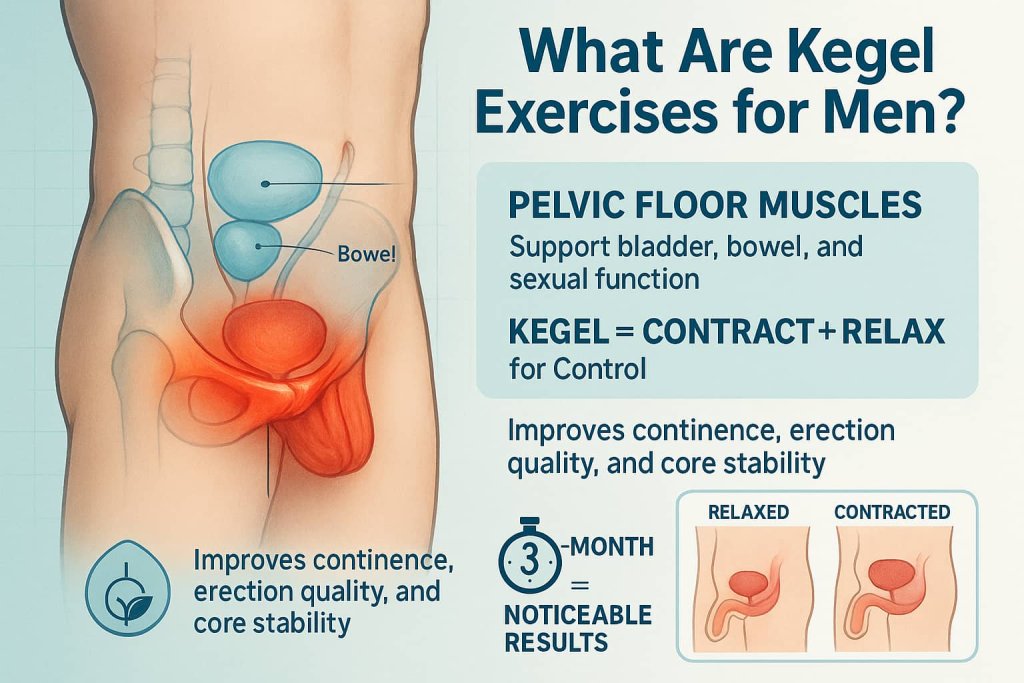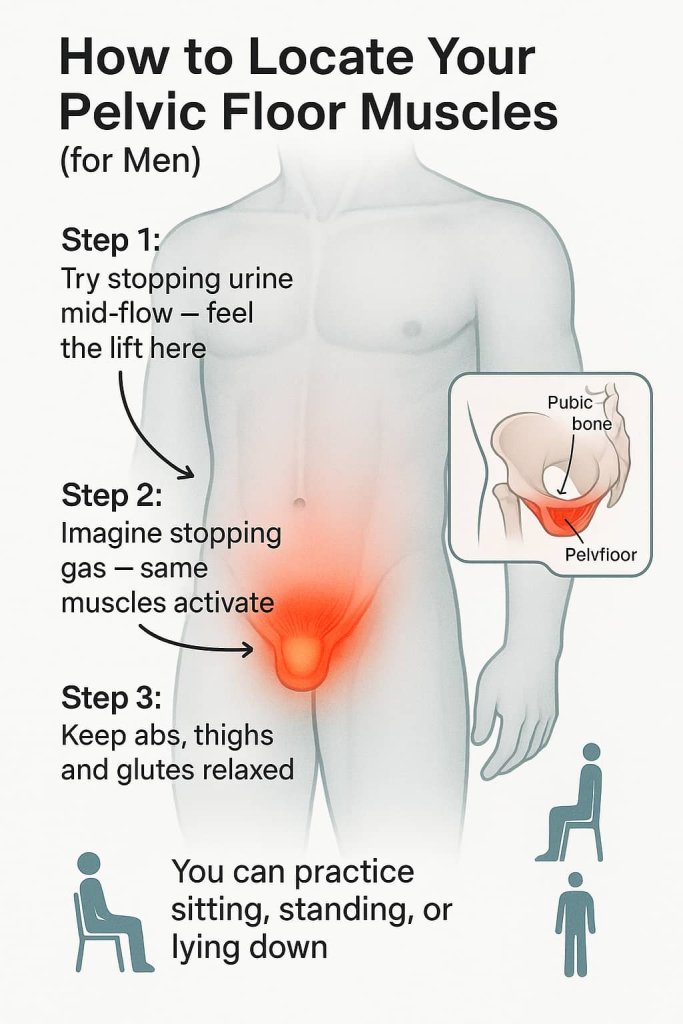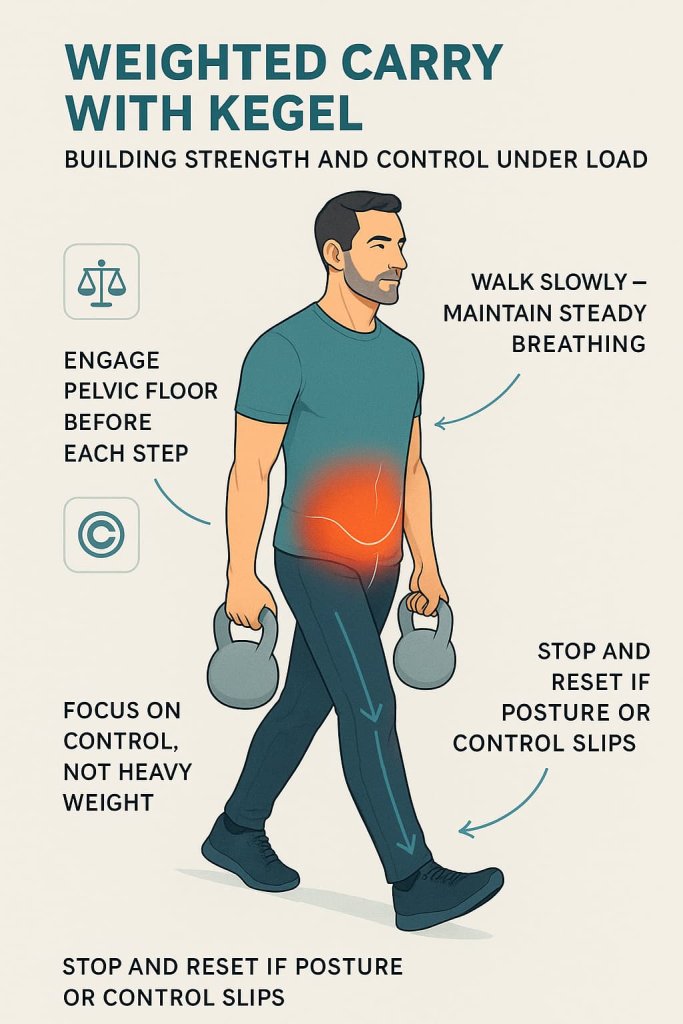Yes — Kegel exercises for men can significantly improve bladder control, sexual health, and overall core stability. These simple yet powerful movements strengthen the pelvic floor — the group of muscles that supports your bladder, bowel, and sexual organs.

Understanding and practicing these exercises properly helps men of all ages prevent leakage, recover after prostate surgery, and enhance performance. In this guide, we’ll break down the 10 best Kegel exercises for men, how to do them correctly, and how to build strength and confidence safely.
What Are Kegel Exercises for Men?
Kegel exercises — or pelvic floor muscle training (PFMT) — involve contracting and relaxing the muscles at the base of your pelvis. For men, these muscles (pubococcygeus, bulbocavernosus, and ischiocavernosus) are essential for bladder control, bowel function, and sexual performance.

Why Kegels Matter for Men
- Reduce urinary leakage after prostate surgery
- Improve bladder and bowel control
- Enhance erection quality and stamina
- Support recovery after pelvic or prostate surgery
- Strengthen core stability and posture
Research Insight:
Evidence shows that structured pelvic floor muscle training can improve urinary continence and erectile function in men; benefits are typically observed after about 3 months of correctly taught practice.Sources: NRU narrative review (2025) and RCT (BJU Int. 2004).
How to Locate Your Pelvic Floor Muscles

Before you begin, you need to find the right muscles.
- While urinating: Try to stop your urine mid-flow (only for awareness, not as an exercise). The muscles you engage are your pelvic floor.
- Without urinating: Imagine stopping gas — you’ll feel a gentle lift inside your pelvis.
- Check alignment: Avoid tightening your abs, thighs, or buttocks — those are helper muscles, not the target.
Once you can isolate these muscles, you can perform Kegels anytime — sitting, standing, or lying down.
How to Do Kegel Exercises Correctly
- Tighten your pelvic floor muscles.
Imagine lifting the area between your scrotum and anus upward. - Hold for 3–5 seconds.
Keep breathing normally — never hold your breath. - Relax for 3–5 seconds.
Release fully before the next rep. - Repeat 10–15 times.
Aim for three to four sets daily in different positions (lying, sitting, standing).
Over time, increase the hold duration to 8–10 seconds per rep as strength improves.
10 Best Kegel Exercises for Men
According to clinical evidence, consistent pelvic floor training can significantly improve bladder control, sexual function, and overall core stability in men.
Performing these 10 Kegel exercises regularly helps build strength, endurance, and confidence in everyday movement and recovery.
1. Basic Pelvic Floor Squeeze (Beginner)
Why it works:
This foundational exercise isolates the pelvic floor muscles without interference from surrounding groups. It improves neuromuscular control, helping you learn to engage the pelvic floor correctly before progressing to advanced positions.
Muscles worked:
Pelvic diaphragm (pubococcygeus, bulbocavernosus, and ischiocavernosus), deep transverse abdominis (stabilizer).
How to do it:
- Lie on your back with knees bent, feet flat on the floor.
- Gently contract the muscles you’d use to stop urine flow.
- Hold for 5 seconds, breathing normally, then relax for 5 seconds.
- Perform 10–15 repetitions.
Trainer Tip:
Place a hand on your lower abdomen — it should stay relaxed. If it tightens or moves, you’re recruiting the wrong muscles.
2. Seated Contraction
Why it works:
This variation adds postural demand, challenging your core and improving pelvic control during sitting activities like driving or working at a desk.
Muscles worked:
Pelvic floor, transverse abdominis, lumbar stabilizers.
How to do it:
- Sit tall on a chair, feet flat, shoulders relaxed.
- Contract your pelvic floor muscles as if lifting them internally.
- Hold for 5–10 seconds, then release completely.
- Repeat 10–15 times.
Trainer Tip:
Keep your chest open and spine upright — good posture increases the effectiveness of the contraction.
3. Standing Hold
Why it works:
Engaging the pelvic floor while standing mimics real-life functional positions — helping you maintain control during movement, lifting, or coughing.
Muscles worked:
Pelvic floor, glutes (stabilizers), deep core stabilizers.
How to do it:
- Stand upright with feet hip-width apart.
- Tighten and lift your pelvic floor muscles.
- Hold for 10 seconds, then rest for 5 seconds.
- Perform 10–12 repetitions.
Trainer Tip:
Avoid holding your breath or squeezing your buttocks. Focus on internal lift and steady breathing.
4. Quick Flicks
Why it works:
Quick, rhythmic contractions target fast-twitch muscle fibers that react to sudden pressure — such as sneezing or laughing. Improves reflexive control.
Muscles worked:
Fast-twitch fibers of the pelvic floor and urethral sphincter.
How to do it:
- Sit or stand comfortably.
- Contract your pelvic floor quickly for 1–2 seconds, then relax completely.
- Repeat 10–15 times per set.
Trainer Tip:
Combine with one long hold afterward (10 seconds) to balance strength and speed.
5. Bridge with Kegel
Why it works:
Integrates the pelvic floor with the glutes and lower core — enhancing stability of the hips and spine. Especially beneficial for men with weak glutes or lower back strain.
Muscles worked:
Pelvic floor, gluteus maximus, hamstrings, core stabilizers.
How to do it:
- Lie on your back, knees bent, feet flat.
- Engage your pelvic floor and glutes simultaneously.
- Lift your hips into a bridge, hold for 5 seconds, then lower slowly.
- Do 10–12 repetitions.
Trainer Tip:
Engage the pelvic floor before lifting your hips — this prevents overuse of the back or glutes.
6. Bird-Dog with Kegel
Why it works:
Combines pelvic floor activation with balance and core coordination, improving spinal stability and control during dynamic movement.
Muscles worked:
Pelvic floor, multifidus, transverse abdominis, glutes, shoulders.
How to do it:
- Begin on all fours.
- Extend your right arm and left leg while tightening the pelvic floor.
- Hold for 5 seconds, return to start, and switch sides.
- Repeat 8–10 times per side.
Trainer Tip:
Keep your spine neutral — avoid arching or twisting your back.
7. Squat with Pelvic Activation
Why it works:
Training your pelvic floor under load improves real-world strength and endurance, especially during lifting or sports movements.
Muscles worked:
Pelvic floor, glutes, quadriceps, adductors, transverse abdominis.
How to do it:
- Stand with feet shoulder-width apart.
- Lower into a squat while contracting your pelvic floor at the bottom.
- Maintain contraction as you return to standing.
- Perform 8–10 repetitions.
Trainer Tip:
Exhale and tighten your pelvic floor during the upward phase for optimal coordination.
8. Standing March with Kegel
Why it works:
Integrates pelvic control with hip flexion — improving coordination, gait stability, and reflexive control during daily movement.
Muscles worked:
Pelvic floor, hip flexors, core stabilizers.

How to do it:
- Stand tall and march in place slowly.
- Engage your pelvic floor each time a knee lifts.
- Continue for 30–60 seconds per set.
Trainer Tip:
Focus on a steady rhythm: lift – squeeze – release. This enhances neuromuscular timing.
9. Long-Hold Challenge
Why it works:
Builds endurance in the slow-twitch pelvic fibers responsible for sustained control during daily activities and prolonged standing.
Muscles worked:
Slow-twitch fibers of the pelvic floor and internal sphincters.

How to do it:
- Engage your pelvic floor gently.
- Hold the contraction for 15–20 seconds, then relax fully.
- Perform 5–8 repetitions.
Trainer Tip:
Avoid over-squeezing; moderate tension sustained longer is better than maximal effort.
10. Weighted Carry with Kegel (Advanced)
Why it works:
Adds real-world loading, training pelvic endurance during movement and resistance. Great for advanced users or athletes.
Muscles worked:
Pelvic floor, glutes, obliques, spinal stabilizers, forearms.

How to do it:
- Hold a light dumbbell or kettlebell in each hand.
- Engage your pelvic floor and walk 20–30 steps slowly.
- Rest, then repeat 2–3 times.
Trainer Tip:
Start light and prioritize pelvic engagement over weight. If control slips, stop and reset before resuming.
Related:
Common Mistakes to Avoid
- Holding your breath (keep breathing naturally).
- Clenching your abs, thighs, or buttocks instead of the pelvic floor.
- Doing Kegels while urinating regularly — this can lead to bladder issues.
- Overdoing it — excessive tension can cause pelvic pain.
Safety and Precautions
- Always consult a doctor before starting if you’ve had pelvic surgery, hernia, or chronic pain.
- Stop immediately if you feel pain or pelvic pressure.
- If you have difficulty isolating muscles, see a pelvic floor physical therapist for guided training.
- Avoid performing while urinating except for identification practice once.
How Often to Do Kegel Exercises
- Beginner: 2–3 sets/day (10 reps each)
- Intermediate: 3–4 sets/day (10–15 reps each)
- Advanced: Hold contractions for 10 seconds, 4–5 sets/day
Consistency is key — aim for daily practice for 6–8 weeks to see results.
Benefits of Regular Practice
- Better bladder and bowel control
- Improved erection strength and endurance
- Faster post-surgery recovery
- Enhanced confidence and quality of life
- Reduced risk of leakage during sneezing, coughing, or exercise
FAQ
Q1. Can Kegel exercises help with erectile dysfunction?
Yes. Studies show pelvic floor training can improve erection quality and stamina in men with mild to moderate ED.
Q2. How long until I see results?
Most men notice improvements in 6–8 weeks of consistent practice.
Q3. Can I do Kegels anywhere?
Yes — they’re discreet and can be done sitting at your desk, standing, or lying in bed.
Q4. Should I use weights or devices?
Only under professional guidance. Beginners should master bodyweight contractions first.
Q5. Are Kegels safe for everyone?
Generally yes, but men with pelvic pain, recent surgery, or medical conditions should seek medical clearance first.
Conclusion
Kegel exercises are one of the most effective ways for men to regain control, build strength, and enhance confidence — naturally. Whether you’re recovering from surgery, addressing urinary leakage, or improving performance, these 10 Kegel variations provide a structured path to stronger pelvic health.
Commit to a few minutes daily, stay consistent for at least two months, and you’ll feel the difference.
Disclaimer:
This content is for informational purposes only and not medical advice. Always consult a healthcare professional before starting any new exercise program, especially after surgery or if you experience pain.
References
- PubMed (BJU Int. RCT) — Pelvic Floor Muscle Exercises for Men with Erectile Dysfunction
https://pubmed.ncbi.nlm.nih.gov/10453864/ - PubMed — Pelvic Floor Muscle Training for Urinary Incontinence After Prostate Surgery (Systematic Evidence)
https://pubmed.ncbi.nlm.nih.gov/24821468/ - European Association of Urology (EAU) — Guidelines: Urinary Incontinence (Men)
https://uroweb.org/guidelines/urinary-incontinence
